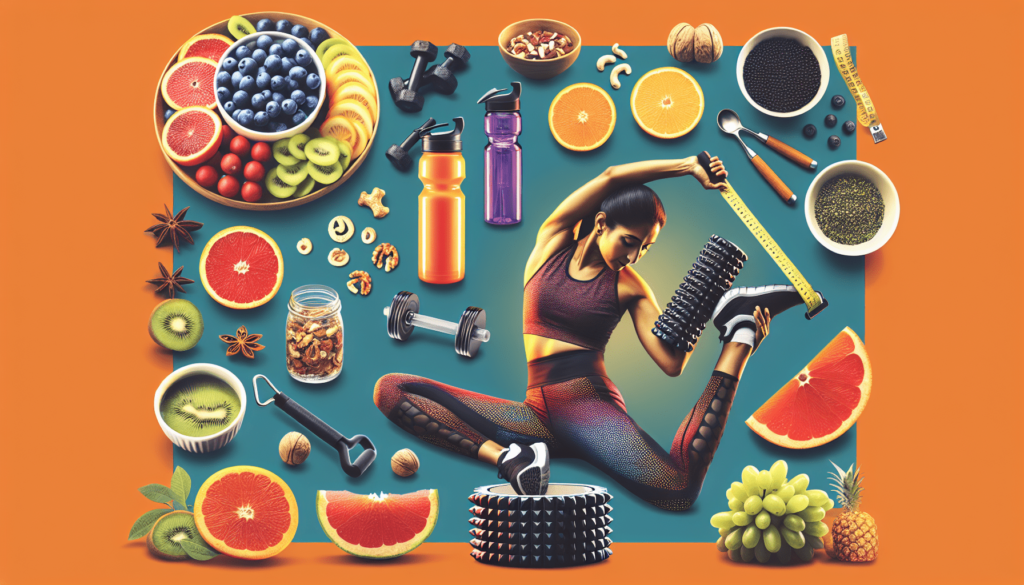So you’ve just had an intense workout session and now you’re left with those familiar aches and pains in your muscles. Don’t worry, you’re not alone. Muscle soreness is a common post-workout sensation that everyone experiences at some point. But wouldn’t it be great if there were some effective ways to recover from and even prevent muscle soreness? Well, you’re in luck. In this article, we will explore some of the best methods to help you bounce back from those sore muscles and keep them at bay in the future. No more letting muscle soreness hinder your progress – it’s time to regain your strength and get back in the game.

Rest and Recovery
Allow Sufficient Rest Periods
Rest is an essential component of any exercise regimen. When you engage in intense workouts, your muscles undergo stress and micro-tears, leading to muscle soreness and fatigue. Allowing sufficient rest periods between workouts is crucial for your muscles to repair and adapt to the stress. If you don’t give your body enough time to recover, you may increase the risk of injury and hinder your progress. Aim to have at least one or two days of rest every week, depending on your fitness level and the intensity of your workouts.
Engage in Active Recovery
Active recovery involves low-intensity exercises and movements that help stimulate blood flow, reduce muscle stiffness, and promote recovery. Engaging in activities such as walking, swimming, or gentle yoga on your rest days can aid in flushing out metabolic waste products from your muscles and improve their recovery. Active recovery also helps with joint mobility and flexibility, preventing stiffness and reducing the chances of injury. So, rather than being completely sedentary on your rest days, try incorporating gentle activities to promote active recovery.
Practice Good Sleep Habits
Sleep is when your body does most of its repair and recovery work. Getting adequate and quality sleep is essential for muscle recovery and growth. During deep sleep, the body releases growth hormone, which plays a crucial role in repairing damaged tissues, including muscles. Aim for 7-9 hours of uninterrupted sleep each night. Develop good sleep habits, such as sticking to a regular sleep schedule, creating a comfortable sleeping environment, and avoiding caffeine and electronics before bedtime. By prioritizing sleep, you can significantly improve your muscle recovery process.
Avoid Overtraining
Overtraining occurs when you push your body beyond its capacity to recover. It can lead to persistent muscle soreness, fatigue, decreased performance, and even injury. To avoid overtraining, listen to your body and pay attention to signs such as excessive fatigue, a decrease in performance, and frequent injuries. Incorporate rest days and active recovery into your routine. Vary the intensity and volume of your workouts to provide your body with the necessary time to recover and adapt. Remember, the goal is progress, not pushing yourself to the point of exhaustion or burnout.
Hydration
Drink Plenty of Water
Staying hydrated is crucial for overall health, including muscle recovery and preventing muscle soreness. Water plays a vital role in transporting nutrients to your muscles and removing waste products. It also helps to maintain optimal muscle function and flexibility. Therefore, it’s important to drink plenty of water throughout the day, especially during and after your workouts. Aim to consume at least 8-10 cups of water daily, and adjust your intake based on your activity level and climate.
Consume Electrolyte-rich Fluids
Electrolytes are minerals that help maintain the balance of fluids in your body and play a crucial role in muscle function and recovery. When you sweat during exercise, you lose electrolytes, which need to be replenished. Consuming electrolyte-rich fluids, such as sports drinks or coconut water, can help restore the electrolyte balance and promote proper muscle recovery. Additionally, including foods rich in electrolytes, like bananas, avocados, and leafy greens, can also contribute to maintaining electrolyte levels in your body.
Stretching Techniques
Static Stretching
Static stretching involves holding a stretch for an extended period, usually around 30 seconds, without any movement. This type of stretching helps improve flexibility, reduce muscle tension, and alleviate muscle soreness. Static stretching should be done after your workouts or on rest days when your muscles are warm. However, avoid static stretching before intense activities, as it can temporarily decrease muscle power. Focus on major muscle groups like quads, hamstrings, calves, chest, and shoulders.
Dynamic Stretching
Dynamic stretching involves moving through a range of motion, mimicking the movements of your workout or sport. This type of stretching helps to increase joint mobility, improve blood flow and muscle activation, and prepare your body for the upcoming activities. Dynamic stretches can include exercises like arm circles, leg swings, or walking lunges. Incorporate dynamic stretching into your warm-up routine to enhance flexibility, performance, and reduce the risk of muscle soreness.
Proprioceptive Neuromuscular Facilitation (PNF) Stretching
PNF stretching is an advanced form of stretching that involves contracting and relaxing specific muscles while stretching them. PNF stretching helps improve both flexibility and strength by activating your muscles and increasing their range of motion. The most common technique is the contract-relax method, where you contract the target muscle for about 10 seconds and then relax and stretch it further. PNF stretching is often performed with a partner, but there are also self-assisted techniques that can be effective.
Massage Therapy
Utilize Self-Massage Techniques
Self-massage can be a valuable tool in promoting muscle recovery and reducing soreness. You can use various techniques such as foam rolling, using massage balls, or handheld massage devices to target specific muscles. Applying gentle pressure and rolling over tight or sore areas can help release muscle tension and improve blood flow, leading to quicker recovery and reduced muscle soreness. Self-massage is convenient and can easily be incorporated into your post-workout or evening routine.
Seek Professional Massage Therapy
If you prefer a more in-depth and targeted approach, seeking professional massage therapy can be highly beneficial. A massage therapist can apply specific techniques to release muscle tension, improve circulation, and promote relaxation. Deep tissue massage, Swedish massage, or sports massage are popular choices for muscle recovery. Professional massage therapy can help identify and address any underlying muscle imbalances or tightness, aiding in better overall musculoskeletal health.

Nutrition
Consume Sufficient Protein
Protein is crucial for muscle repair and recovery. It provides the building blocks (amino acids) necessary for repairing damaged muscle fibers and building new ones. Include protein-rich foods such as lean meats, poultry, fish, eggs, dairy products, legumes, nuts, and seeds in your diet. Aim for a protein intake of approximately 0.8-1 gram of protein per kilogram of body weight. If you engage in intense workouts or strength training, you may require a slightly higher protein intake to support optimal muscle recovery.
Include Anti-inflammatory Foods
Inflammation is a natural response that occurs after exercise-induced muscle damage. While it is a part of the healing process, excessive inflammation can contribute to muscle soreness and delayed recovery. Including anti-inflammatory foods in your diet can help mitigate this inflammation. Foods rich in omega-3 fatty acids, such as fatty fish (salmon, mackerel), walnuts, and flaxseeds, have powerful anti-inflammatory properties. Additionally, fruits and vegetables high in antioxidants, such as berries, leafy greens, and tomatoes, can also help reduce inflammation and promote faster recovery.
Consider Nutritional Supplements
Nutritional supplements can be a helpful addition to your muscle recovery routine, but they should not replace a balanced diet. If you’re not meeting your protein needs through whole food sources, protein supplements like whey protein or plant-based protein powders can be convenient options. Branched-chain amino acids (BCAAs) are also popular among athletes as they can help reduce muscle soreness and enhance recovery. However, it’s important to consult with a healthcare professional or registered dietitian before adding any supplements to your routine, as individual needs may vary.
Ice and Heat Therapy
Apply Ice Packs
Ice therapy, also known as cryotherapy, involves applying cold packs or ice to sore or inflamed muscles. The cold temperature helps reduce inflammation, numb pain, and constrict blood vessels, limiting swelling and fluid buildup. Ice packs can be particularly effective when applied within the first 24-48 hours after intense exercise or injury. Apply ice packs to the affected area for about 15-20 minutes at a time, ensuring you don’t apply ice directly to the skin to prevent ice burns. Repeat the process as needed to alleviate muscle soreness and promote recovery.
Utilize Heat Therapy
Heat therapy, also known as thermotherapy, involves applying heat to the muscles to increase blood flow, relax muscles, and promote healing. Heat can also help reduce muscle stiffness and soreness. You can use a heating pad, warm towels, or take a warm bath or shower to apply heat to the affected area. Make sure the temperature is not too hot to avoid burns. Heat therapy is particularly beneficial after the first 48 hours of an injury or exercise-induced muscle soreness when inflammation has subsided, and gentle heat can help with muscle relaxation and recovery.
Foam Rolling
Perform Foam Rolling Exercises
Foam rolling is a form of self-myofascial release that involves using a foam roller to apply pressure and release muscle tension. It helps break up adhesions or knots in the muscle tissue, improve blood flow, and reduce muscle soreness. Foam rolling can be particularly effective for larger muscle groups such as calves, quadriceps, hamstrings, and the upper back. Roll slowly over the targeted area, applying moderate pressure and pausing on any tender spots for 20-30 seconds. Incorporate foam rolling into your post-workout routine or on rest days to aid in muscle recovery.
Target Specific Muscle Groups
Foam rolling can be customized to target specific muscle groups that tend to be tight or prone to soreness. By identifying your problem areas, such as tight hamstrings or calves, you can focus your foam rolling efforts on those specific muscles. Spend a few extra minutes on each targeted muscle group, working in small, controlled movements and adjusting your body position to apply pressure to different angles. Remember to breathe deeply and relax into the foam roller, allowing the muscles to release tension and facilitating faster recovery.
Proper Warm-up and Cool-down
Engage in Dynamic Warm-up
A proper warm-up is essential for preparing your muscles and joints for exercise and reducing muscle soreness. Dynamic warm-up involves performing movements that mimic the activity you are about to do, increasing blood flow, activating muscles, and improving range of motion. Incorporate exercises such as walking lunges, jumping jacks, high knees, or arm circles into your warm-up routine. Gradually increase the intensity and range of motion as you warm up, focusing on the major muscle groups you will be using during your workout.
Incorporate Mobility Exercises
Mobility exercises are designed to improve joint range of motion and maintain proper movement patterns. By incorporating mobility exercises into your warm-up routine, you can reduce the risk of muscle imbalances, joint restrictions, and muscle soreness. Include exercises such as hip circles, shoulder rotations, or ankle mobility drills to target specific joint areas. Focus on areas that may be tight or restricted, allowing for greater joint mobility and improved overall movement mechanics.
Gradually Decrease Intensity
Cooling down after your workout is just as important as warming up. Gradually decreasing the intensity of your exercise allows your heart rate to return to its resting state and helps remove metabolic waste products from your muscles. This gradual cool-down can be achieved by reducing the intensity and speed of your movements or incorporating static stretches for the major muscle groups used during your workout. Taking the time to cool down properly can aid in reducing muscle soreness and promoting overall muscle recovery.
Gradual Progression
Start with Low Intensity and Volume
When starting a new exercise program or changing your routine, it’s important to begin with low intensity and volume. This allows your body to adapt gradually and reduces the risk of excessive muscle soreness or injury. Start with lighter weights, shorter durations, or lower impact activities and gradually increase the intensity and volume as your body becomes more conditioned. Giving your muscles time to adapt and recover between workouts is vital for long-term progress and preventing muscle soreness.
Gradually Increase Intensity and Volume
As your fitness level improves, you can gradually increase the intensity and volume of your workouts. This progressive overload helps challenge your muscles and promotes continued growth and adaptation. However, it’s crucial to progress gradually to avoid overtraining and excessive muscle soreness. Gradually increase the weight, duration, or intensity of your workouts by small increments, allowing your body to adapt and recover between each progression. Remember, slow and steady progress is key to avoiding muscle soreness and sustaining long-term results.
Cross Training
Incorporate Different Training Modalities
Cross training involves incorporating a variety of exercises or activities into your fitness routine. By engaging in different training modalities, such as aerobic exercises, strength training, yoga, or swimming, you can work different muscle groups, improve overall fitness, and reduce the risk of overuse injuries and muscle imbalances. Cross training also provides mental stimulation and helps prevent boredom, making it easier to stick to your exercise routine. Include a mix of activities that you enjoy and that challenge your body in different ways for optimal muscle recovery and overall well-being.
Alternate High and Low Impact Activities
To prevent excessive strain on your muscles and joints, it’s beneficial to alternate between high and low impact activities. High impact exercises, such as running or jumping, place a significant load on your muscles and joints, which can lead to muscle soreness and potential overuse injuries. By incorporating lower impact activities, such as cycling, swimming, or yoga, you can give your body a break from the repetitive high impact movements while still engaging in physical activity. This balance between high and low impact exercises allows for adequate muscle recovery and helps maintain long-term joint health.
